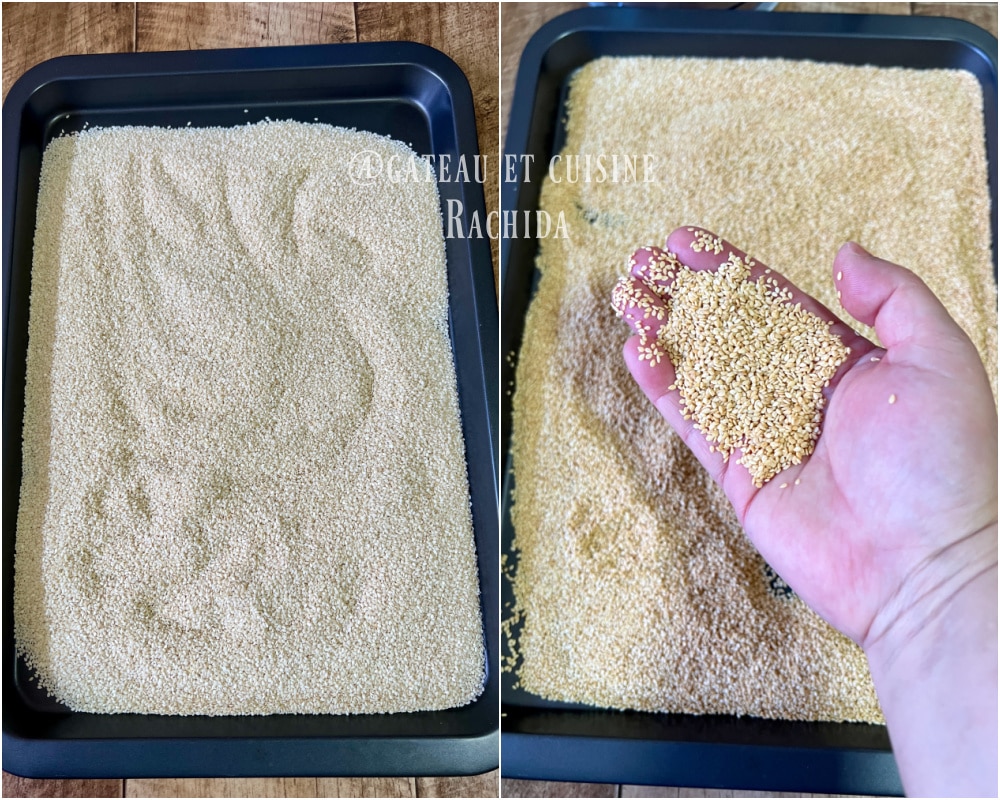Tahini, also known as tahin or tahina is a cream made from roasted sesame seeds, ground to a smooth, creamy paste rich in calcium. It is featured in many recipes across several Middle Eastern countries, including Lebanese, Syrian cuisine, and more.
Tahini is widely used in many recipes, including hummus, salad dressings and marinades.

Homemade Tahini
Making homemade tahini is really very simple and less expensive than store-bought tahini. I use it very often in sauces to accompany mezzes, falafels or hummus. Tarator sauce with tahina is a famous accompaniment to grilled meats, chicken, etc…
To make a good tahini, all you need are roasted sesame seeds and about 15 minutes of your time. This ensures that it contains no additives such as palm oil. As I’ve told you in several of my posts, I’ve been a fan of homemade food ever since I started cooking. I find it better, more economical and healthier, with no additives or preservatives.
Spreads and dried fruit purees, which are used in many recipes, are among the things I almost never buy.
I had already suggested the homemade nutella which is delicious. I often make a mixture of fruit purees (almonds, sesame seeds and hazelnuts) that I sweeten with honey to make a healthy spread. You can add a little melted chocolate or sugar-free cocoa. 
Table of Contents
What you’ll love about tahini
Only one ingredient, sesame seeds, and nothing else. There’s no need to add oil, just be patient until the sesame seeds release their own oil. However, there’s nothing to stop you adding a little neutral oil, preferably sunflower oil, light olive oil or a little sesame oil to help the food processor.
You can add 1 pinch of salt to enhance the taste.
Easy to prepare, all you need is a good food processor like the Moulinex 123, or if you have the Thermomix, it’s even better for grinding roasted sesame seeds. You can also use a smoothie blender that has the option of crushing ice cubes.
If your robot is not very powerful, take a break to let the motor cool down. Grind small quantities according to the capacity of the food processor’s bowl, filling it halfway unless it is powerful.
Nutritional value: Tahini is a source of plant-based protein, healthy fats, fiber, and various essential nutrients such as calcium, iron, magnesium, and zinc, making it an excellent nutritional choice for a balanced or vegan diet.
Versatile, Tahini can be used in a variety of recipes, making it a favorite in many cuisines around the world. It can be used in both savory and sweet dishes, from hummus, salad dressings and marinades to desserts such as cakes and cookies, where it replaces oil or butter.

How do I make homemade tahini ?
| NB: Find the complete recipe with detailed ingredient quantities in the recipe- card at the end of the article, which you can also print out. Below are the instructions, which you can also view in images. |
You can roast the sesame seeds in the oven or in a frying pan, stirring constantly until lightly browned.
1. Preheat your oven to 175°C (350°F).
2. Spread the sesame seeds on a rimmed baking sheet and toast in the oven until lightly browned, stirring occasionally. Be careful not to burn them.
3. Pour the roasted sesame seeds into a dish to stop the cooking.
4. Allow to cool slightly before pouring into a blender or food processor.
4. Blend at maximum speed, stopping from time to time to scrape the edges and allow the blender motor to cool if necessary (it should not heat up).
5. Blend until smooth and creamy.
6. The process starts with a powder, then becomes a thick paste. By continuing to blend, the sesame seeds release their oil and the texture becomes smooth and creamy.
7. You can add a little oil to help the food processor. I don’t use any, just blend, pausing, until I get a smooth, creamy, fairly runny texture.
8. Add a pinch of salt and blend one last time.
9. Pour the tahini into a jar with a tight-fitting lid and store in the cupboard for up to 1 month, or in the refrigerator for up to 3 months.

Homemade Tahini (sesame paste) Recipe
EQUIPEMENTS
- Food processor
INGREDIENTS
- 1/2 kg sesame seeds (17.6 oz) (white or brown, brown sesame seeds give a darker tahini) You can use as many sesame seeds as you like.
- Oil neutral such as grape, sunflower or sesame oil (optional)
- A pinch of salt (optional)
PREPARATION
- You can roast the sesame seeds in the oven or in a frying pan, stirring constantly until lightly browned.
- Preheat your oven to 175°C (350°F).
- Spread the sesame seeds on a rimmed baking sheet and toast in the oven until lightly browned, stirring occasionally. Be careful not to burn them.
- Pour the roasted sesame seeds into a dish to stop the cooking.
- Allow to cool slightly before pouring into a blender or food processor.
- Blend at maximum speed, stopping from time to time to scrape the edges and allow the blender motor to cool if necessary (it should not heat up).
- Blend until smooth and creamy.
- The process starts with a powder, then becomes a thick paste. By continuing to blend, the sesame seeds release their oil and the texture becomes smooth and creamy.
- You can add a little oil to help the food processor. I don't use any, just blend, pausing, until I get a smooth, creamy, fairly runny texture.
- Add a pinch of salt and blend one last time.
- Pour the tahini into a jar with a tight-fitting lid and store in the cupboard for up to 1 month, or in the refrigerator for up to 3 months.
Thank you for visiting my blog and your comments.
You can follow me on my Youtube channel
